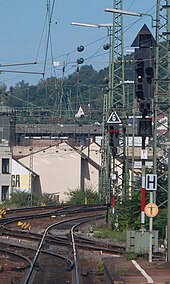Identification light
The identification light is a white light on the light signals of the railways in Germany, which indicates that the signal is temporarily switched off by the responsible dispatcher or automatically by the signaling technology . The driver does not need to heed the signal.
Purpose of the identification light
A dark light signal is considered to be disturbed on the railway. A mast sign attached to the signal can oblige you to stop. Continuing the journey is only permitted on special order, for example a written order , substitute signal or caution signal . Similarly, a stop would be expected with pre-signals due to the pre-signal board. For this reason, a white light is shown when the signals are switched off.
application
The identification light is used in both the H / V (only for light signals), Hl and Ks signal systems. Detached distant signals that are not operationally used also show a marker light, while distanced distant signals on the mast of a main signal are switched to dark. Stand-alone additional signals remain dark.
commitment

At main signals
The beacon is mostly used when two main signals do not follow each other within the braking distance . The problem here is that it would not be possible to stop in time. If the travel path is adjusted from the first signal via the second to a third signal, the second signal is switched to a beacon. The route is then secured by the first signal. Other combinations are possible.
If the route is only taken up to an intermediate signal, the dead-end and early- stop indicator in the form of a T turned 90 ° to the left may be used on the preceding signal.
In the case of small railways , on branch lines , park railways or temporarily unoccupied operating points, there is the option of operating the beacon , whereby the signals of the unoccupied operating point of the secured route are switched off and only show the beacon. This enables, for example, a train station to be operated with fewer staff at times. The security of the rail traffic is taken over by the remote operating point.
In certain cases (if the route book is regulated or other signal in the track driving position shows) the characteristic light can also consent to the exit in a train station. In this case, according to the latest regulation, a speed of 40 km / h must not be exceeded until the next main signal.
At blocking signals
Before vehicles can be moved, the switchman's consent is usually required. The switch attendant indicates that he has approved the journey, for example by setting the blocking signal to move. If the points and locking signals are to be operated in a defined area of a train station on site, a so-called local control area is activated. If now in this area Rangierfahrweg set by a disable signal from the characteristic light is at this blocking signal is turned on (former name: Rangierkennlicht ).
Web links
Individual evidence
- ↑ Compilation of the Railway Signal Regulations (ESO) according to BMVBS and DB (as of June 5, 2011) ( Memento of the original from March 4, 2016 in the Internet Archive ) Info: The archive link was automatically inserted and not yet checked. Please check the original and archive link according to the instructions and then remove this notice. (PDF; 852 kB), page 18.

